Estimated reading time: 14 minutes
This Black Powder Project has always been about the “weapon” aspect of guns. Except perhaps for hunting, most people don’t think about black powder guns in the weapon context, even though back in the day, black powder guns were a revolution in weapons.
There are collectible guns. There are historical guns. Some guns give you an extra week and sometimes an extra deer for deer season. But at the heart of all guns are tools created as weapons. And though the technology is old, black powder guns are guns, and very effective weapons.
Table of contents
- Ballistics
- The Math of Ballistics
- Black Powder Substitute
- Why I Care
- The Black Powder Project Guns
- Call It Buntline Or Bison
- Roundballs
- Black Powder of Choice
- Cartridge Kits
- Does Size Really Matter?
- Testing Different Guns
- Loading
- READ MORE: Modern Underrated Guns – Appreciate ’em
- Conclusion On Black Powder Ballistics
Ballistics
“Ballistics” is how we measure the technical proficiency of a load in a specific firearm, and it is composed of many factors. The weight of the projectile calculated with the speed at which it leaves the barrel is usually measured in foot-pounds. The more foot-pounds, the harder it hits, which I’ll explain. For long range, the shape of the bullet is also a factor in its role to buck the wind as it goes down range. This is called the ballistic coefficient, and for black powder, it usually isn’t that much of a factor because heavy slow bullets buck the wind really well.
For pistols (and yes, all handguns are pistols), close-range effectiveness is what we expect, and what we are trying to measure. But foot pounds don’t always tell the whole story. This is because in the equation to measure foot/pounds, velocity is squared, or multiplied times itself. The weight in grains of the bullet is only factored in once. That is then multiplied by a constant.
The Math of Ballistics
-Weight of the bullet (in grains) x velocity (in feet per second) x velocity again x 0.000002218 = muzzle energy in foot-pounds.
So a light bullet that travels faster is always going to have more foot-pounds of energy than a heavy bullet going slower. In practice, the numbers don’t always foretell the actual effectiveness of the load. This has led to endless arguments of 45ACP vs. 9mm and in the modern day 5.56NATO vs. 300BK. Heavier bullets hit harder, and tend to punch through more things. But the numbers give us an apples-to-apples comparison when weight and velocity are similar from load to load.
I have used a website called Ballistics by the Inch when I try to wrap my head around the factors of a new caliber when it comes to handguns. At some point, they burned a lot of ammo to come up with those numbers, and I am not aware of any other source as comprehensive.
Black Powder Substitute
For black powder, or by my preference, a black powder substitute, there is no data out there whatsoever. I have covered some basic velocity in this series over the years, just to show how effective these guns can be. But I have never measured head to head one barrel length against another.
So I decided to measure it, and compare the data to BBTI, trying to match up the weight of the bullet and the velocity that I measured with my chronograph for the various barrel lengths that are available out there in black powder guns.
…even if only five people in the world actually care.
Why I Care
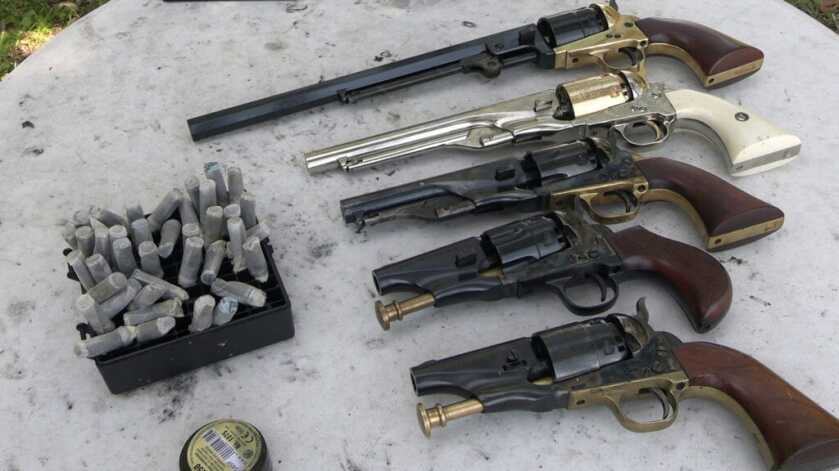
The reason I care is because I have carried these guns in daily life many times. In the days before the reciprocity of carry permits, I carried cap-and-ball revolvers whenever I traveled. Since those days some states have gotten wise and incorporated “any weapon that fires a projectile” language, but back then it was not the case. Having shot SASS back in the 90s with my cap-and-ball guns, I am pretty natural with them, and I would be equally as comfortable carrying them today.
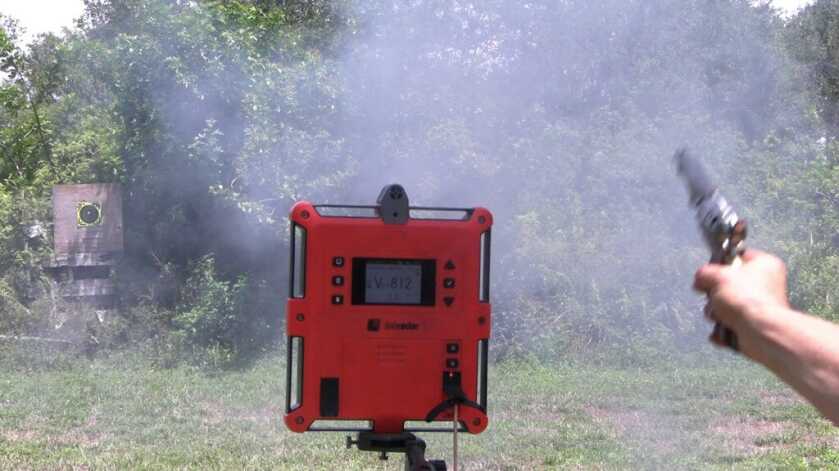
But are they effective in the shorter sizes that are easier to carry? I didn’t know. They are guns of course, and the gun you can carry and will carry is always better than no gun at all. I was curious. So I measured it.
The Black Powder Project Guns
As you can see in the video, I used my old 1860 Army 3” snubbie as the shortest of the lot. I bought it out of the Cabelas print catalog decades ago, and you don’t see that model around these days. It has been replaced by Pietta with the same model, but with a bird’s head grip, like Billy the Kid’s gun. And though I’m sure many original 1860 Army Colts were cut down back in the day, there is no historical gun like the bird’s head model.
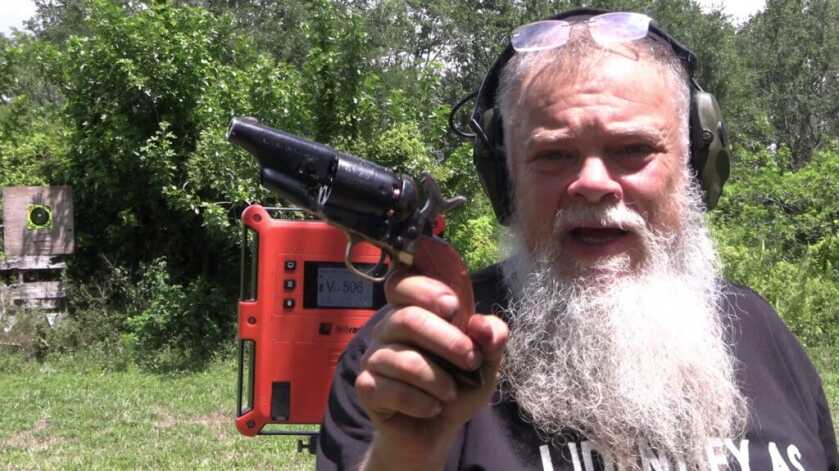
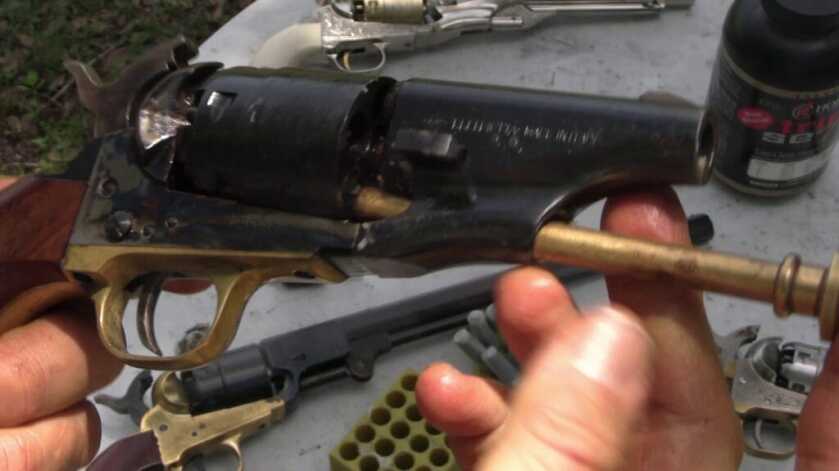
It was made to actually carry.
I also tried one of my 1851 Navy “Marshall” Colts, which you can still find for sale today. It has a 5 ½” barrel, and I had mine tuned up so it is super slick, and it has the little post to prevent the cap from jamming the action. Note that on the EMF website, you can order out-of-stock items and they will call you and only charge if and when it ever comes in again.
Call It Buntline Or Bison
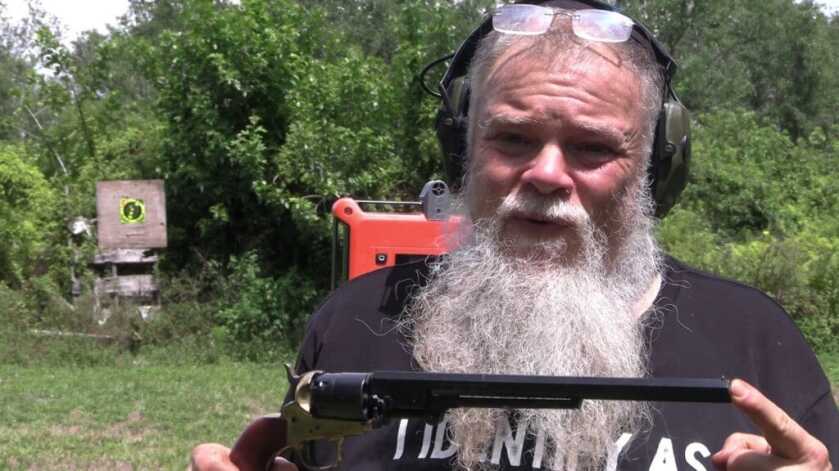
And I had to include the 12” barreled Buntline because I have a couple. Most of you have probably never even seen a Buntline at all, never mind in black powder. The gun was the concept of Ned Buntline, the author who originally fictionalized the shootout a the OK Corral, and though there is no evidence that Wyatt Earp carried one, as western guns the Buntline has always been a fascination, and in demand by consumers. Pietta calls them the Bison, which reflects why they are interesting. If you are in a part of the country where buying a handgun is a headache, yet would like something somewhat compact as a range gun, I think the Bison is a great fit.
Roundballs
I used roundballs for my test because, for one, I am not Ballistics by the Inch. This was not meant to be an exhaustive test, and frankly, most people shoot roundballs in these guns. See my older stuff on the Johnson & Dow conical, the Walker, the Kerr, and a 225-grain flat nose I found at Accurate Molds. Back in the day of these guns, plenty of people shot roundballs, but conicals were issued to most Civil War soldiers.

Practically speaking, a heavier bullet is better for longer-barrel black powder firearms, because of the issue of leading. A 140-grain roundball is fast with black powder, and it can be too fast. Over 1,000 feet per second, a 100% lead bullet with no jacket tends to leave some lead in the barrel, and it is tough to get out. In bullets meant for cartridge firearms, you just add a little tin and antimony to create an alloy and this makes the bullet much harder. But with cap-and-ball guns, you have to shave the bullet as you push it into the chamber, and that is tough to do with harder lead alloys.
Black Powder of Choice
My powder, when possible (not in flintlocks), is always Hodgdon Triple Se7en. It produces more velocity, and I have never had any indication that a gun was overloaded, no matter how much of it I have squished in there. The big advantage of Triple Se7en is of course that you don’t have to freak out to clean your guns as quickly as with black powder, and it is more forgiving if you miss a spot. The data on the front of the Triple Se7en can is for deer rifles. My data probably isn’t novel, but I’ve never seen it before.
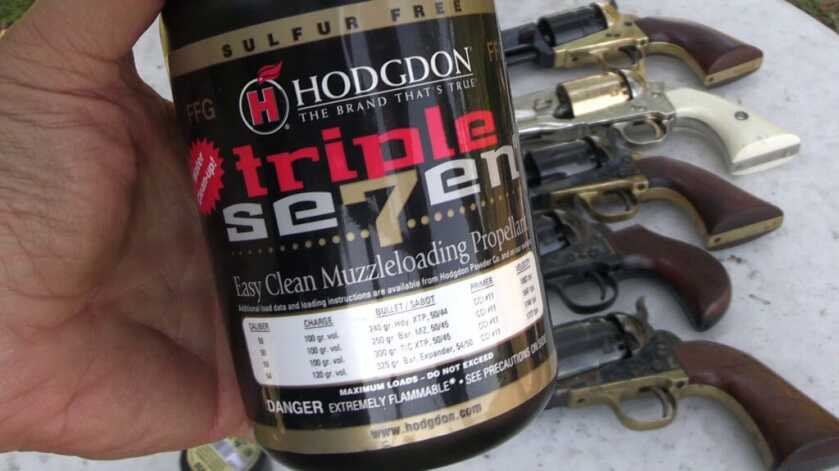
Cartridge Kits
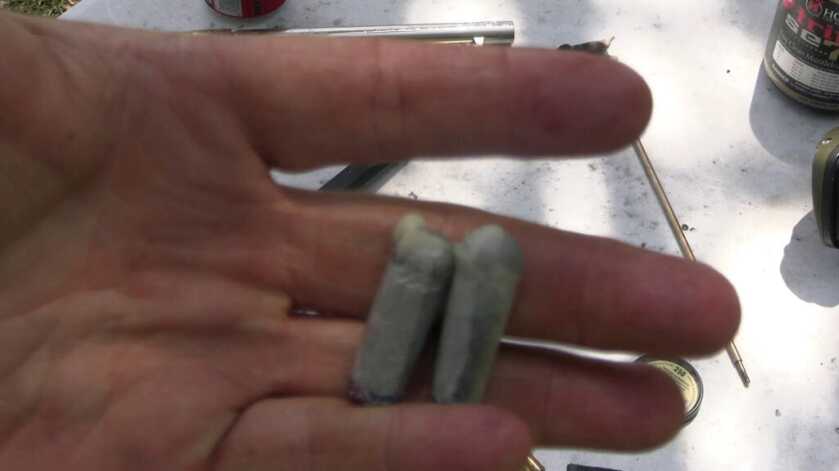
And as you can see from the video, I use pre-made paper cartridges when I work on these projects. The kit I use is at cartridgekits.com (http://www.cartridgekits.com), and they make kits for all of the pistols, as well as the 12 gauge Diablo/Desperado, and inline muzzleloaders. I was the primary engineer for these kits, so they work well. My method for these specific rounds was to fill the dipper so that you could see the rim of the dipper. This is the conservative Colt load, and as you can see, pushes a roundball at velocities that won’t cause leading. When you load roundballs with these kits, you extend the paper outside of the dowel, which leaves a cup at the end for the ball. Just be careful not to overload them, as much more powder than that will cause leading.
First, let’s compare the conservative ballistics of a standard 7 ½” Colt 1860 with roundballs. I was weary about leading in the buntline, and I wanted all of the powder to be equal, So the velocity was around 950 feet per second. Plugging that into our formula above with a 140-grain roundball, it equals 280 foot pounds of energy. That equates to about a 135-grain bullet in a 3” 38 Special revolver using the graph at Ballistics by the Inch. There is no comparable bullet for a 44 Special because factory ammunition is all conicals which are heavier in that caliber. But the foot-pounds are about the same as a 165-grain bullet in a 2-3” barrel.
Does Size Really Matter?

In a 9mm (www.ballisticsbytheinch.com/megraphs/9mm.html), the heavier bullets for the gun cross the 280 zone between 3 and 4-inch barrels. And even the venerable 45ACP crosses down into the 280 with 2 and 3 in barrels. I currently have one of those in my pocket.
So you see that even a modest roundball load with a standard-length Colt packs a punch. Loaded up to snot with a heavier conical, the ballistics are even more impressive in the numbers, as well as in the field.
Testing Different Guns
The 5 ½” Marshall lost a couple hundred feet per second, floating around 750. That drops us down to 174 foot pounds. In 38 Special the 2 and 3” cross into those values with the heavier bullets for the caliber. None of the 9mm falls that low, but the .380 is solid in that zone with under 100-grain bullets. It is safe to load this gun right up to snot, which will produce marginally more velocity. But remember, we are dealing with a slow black powder substitute, so loading the gun up will generally only make a bigger fireball as the extra powder burns outside the barrel.
The 3” barrel 1860 Army is even worse. At 550 feet per second, the bullet now leaves the barrel with 93 foot-pounds of energy. Now we are down in the territory of the 32ACP. The .22 Mag and 25 Auto are also down in this range, but all of these guns are with much lighter bullets, some even under 50 grains.
You can see from this data how velocity skews and even perverts the measurement of a firearm’s effectiveness. Would you rather be hit with a .22 Mag in a 2” gun, a 25 Auto, or this short 44? I know my answer. Those guns could all fail to penetrate your clothes, depending on what you are wearing. But the 44 will most likely go right through you and come out the other side.
Loading

In the Buntline/Bison data, you can see what I meant about loading. My conservative loads were already around 1,100 feet per second, just south of supersonic. And even the diminutive roundball was already pushing 375 foot-pounds, with the same exact load as in the shorter guns. That is outside the bounds of 9mm in standard barrel lengths. In a 44 Special it equates to a 4 or 5 inch barrel. And even in the 45 ACP many of the loads fall in that range with a 4 and 5 inch barrel.
READ MORE: Modern Underrated Guns – Appreciate ’em
It completely outclasses the 38 Special in its standard 6” barrel, and the 38 was carried as the predominant caliber by both military and police prior to World War II. With a heavier bullet, like a 250-grain Johnson & Dow, this gun will be a beast when loaded up to snot. And the velocity should stay under supersonic, so there should be no real leading problem.
Conclusion On Black Powder Ballistics
My goal here was to demonstrate the disparity in velocity with guns that most people take for granted. The same ball, with the same powder charge, can by the numbers match a 25 Auto, and outclass a 38 Special, depending on barrel length alone. And that is with a powder that is closer to smokeless than it is to black. If you were shooting actual black powder the results would probably be even more amplified and disparate. But at the end of the day, I would stand at 100 yards and let you take a shot at me with any of these guns. Black powder firearms aren’t firearms according to the Federal Government and most states. There is no record kept of who has them, and nobody is on a mission to change that anytime soon. And yeah, they work pretty well.
*** Buy and Sell on GunsAmerica! ***

Hi, Paul. Gonna go out on a limb here regarding your last paragraph and assume it’s a typo when you said you WOULD stand at 100 yards and let folks pop a cap at you with these pistols. Very in depth article! I didn’t figure on the huge disparities in velocity for the same loads using BP.
This is a great article in so many ways. You answer so many questions that have intrigued me. Thanks. Louis